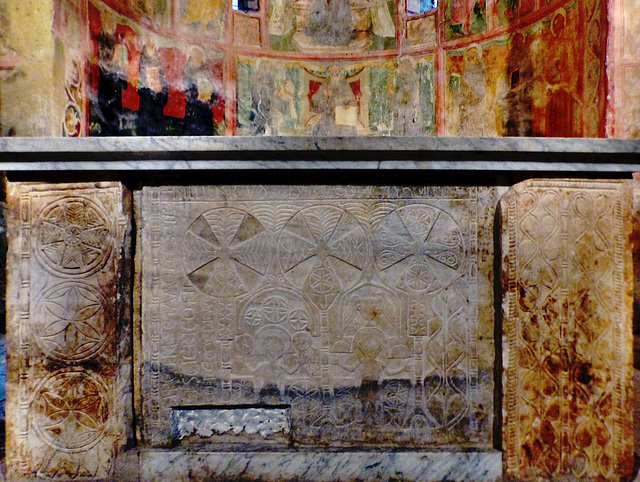Location
See also...
Keywords
Authorizations, license
-
Visible by: Everyone -
All rights reserved
-
152 visits
Ferentillo - Abbazia di San Pietro in Valle


Two Syrian hermits named Lazzaro and Giovanni had lived in the 5th century, where Faruald, Duke of Spoleto, founded this abbey within the 8th century "over the hermits´ tombs". In 724, Faroald's son Thrasimund rebelled and disposed his father into the monastery. For some generations the abbey was the burial ground for the Dukes of Spoleto
Saracen troops looted and destroyed the Benedictian abbey end of the 9th century, but Otto III ordered a rebuilding soon after. In 1016 the abbey was completed.
There is a long discussion about the church, as it may not have been "destroyed", but maybe was only "damaged" by the Saracens. In "Ombrie romane" Adriano Prandi cites a couple of scholars who date the church back to the 8th century, while he (taking in account the T-floorplan) dates it to the first half of the 11th. He actually connects this church to Cluny II and Saint Michael in Hldesheim, both completed somne decades before 1000.
When Otto III, son of Otto II and his wife Theophanu, marched through on 996 in his way to Rome, where he claimed the titles King of Italy and Holy Roman Emperor, he may have been accompanied by experienced and well travelled architects. They may have cared for the rebuilding of the church, that Otto III had ordered.
This sculpted slab (now part of the altar) is (for me) the most important piece of art in this church. It is dated to the 8th century - and their is no discussion about it, as donor and artist are both mentioned.
Carved in (left) is the inscription
"HILDERICUS DAGILEOPA IN ONOREM S(an)c(t)I PETRI ET AMORE S(an)C(t)I LEO ET S(an)C(t)I GRIGORI I P(ro) REMEDIO A(ni)M(ae)."
This translates to
"Hildericus Dagileopa, in honor of St. Peter and for the love of St. Leo and St. Gregory, for the salvation of the soul."
Hilderic was appointee of Liutprand, King of the Lombards, against the rebellious Thrasimund II. Liutprand took Spoleto in 739
and appointed Hilderic as Duke of Spoleto. Thrasimund fled. Luitprand besieged him in Rome. Peace was mediated between Liutprand and Pope Gregory III by envoys of Charles Martel. Thrasimund soon after retook Spoleto and killed Hilderic.
Saracen troops looted and destroyed the Benedictian abbey end of the 9th century, but Otto III ordered a rebuilding soon after. In 1016 the abbey was completed.
There is a long discussion about the church, as it may not have been "destroyed", but maybe was only "damaged" by the Saracens. In "Ombrie romane" Adriano Prandi cites a couple of scholars who date the church back to the 8th century, while he (taking in account the T-floorplan) dates it to the first half of the 11th. He actually connects this church to Cluny II and Saint Michael in Hldesheim, both completed somne decades before 1000.
When Otto III, son of Otto II and his wife Theophanu, marched through on 996 in his way to Rome, where he claimed the titles King of Italy and Holy Roman Emperor, he may have been accompanied by experienced and well travelled architects. They may have cared for the rebuilding of the church, that Otto III had ordered.
This sculpted slab (now part of the altar) is (for me) the most important piece of art in this church. It is dated to the 8th century - and their is no discussion about it, as donor and artist are both mentioned.
Carved in (left) is the inscription
"HILDERICUS DAGILEOPA IN ONOREM S(an)c(t)I PETRI ET AMORE S(an)C(t)I LEO ET S(an)C(t)I GRIGORI I P(ro) REMEDIO A(ni)M(ae)."
This translates to
"Hildericus Dagileopa, in honor of St. Peter and for the love of St. Leo and St. Gregory, for the salvation of the soul."
Hilderic was appointee of Liutprand, King of the Lombards, against the rebellious Thrasimund II. Liutprand took Spoleto in 739
and appointed Hilderic as Duke of Spoleto. Thrasimund fled. Luitprand besieged him in Rome. Peace was mediated between Liutprand and Pope Gregory III by envoys of Charles Martel. Thrasimund soon after retook Spoleto and killed Hilderic.
- Keyboard shortcuts:
Jump to top
RSS feed- Latest comments - Subscribe to the comment feeds of this photo
- ipernity © 2007-2024
- Help & Contact
|
Club news
|
About ipernity
|
History |
ipernity Club & Prices |
Guide of good conduct
Donate | Group guidelines | Privacy policy | Terms of use | Statutes | In memoria -
Facebook
Twitter

Sign-in to write a comment.